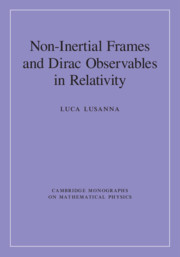Book contents
- Frontmatter
- Dedication
- Contents
- Preface
- Part I Special Relativity: Minkowski Space-Time
- 1 Galilei and Minkowski Space-Times
- 2 Global Non-Inertial Frames in Special Relativity
- 3 Relativistic Dynamics and the Relativistic Center of Mass
- 4 Matter in the Rest-Frame Instant Form of Dynamics
- Part II General Relativity: Globally Hyperbolic Einstein Space-Times
- Part III Dirac–Bergmann Theory of Constraints
- Appendix A Canonical Realizations of Lie Algebras, Poincaré Group, Poincar´e Orbits, and Wigner Boosts
- Appendix B Grassmann Variables and Pseudo–Classical Lagrangians
- Appendix C Relativistic Perfect Fluids and Covariant Thermodynamics
- References
- Index
3 - Relativistic Dynamics and the Relativistic Center of Mass
from Part I - Special Relativity: Minkowski Space-Time
Published online by Cambridge University Press: 17 June 2019
- Frontmatter
- Dedication
- Contents
- Preface
- Part I Special Relativity: Minkowski Space-Time
- 1 Galilei and Minkowski Space-Times
- 2 Global Non-Inertial Frames in Special Relativity
- 3 Relativistic Dynamics and the Relativistic Center of Mass
- 4 Matter in the Rest-Frame Instant Form of Dynamics
- Part II General Relativity: Globally Hyperbolic Einstein Space-Times
- Part III Dirac–Bergmann Theory of Constraints
- Appendix A Canonical Realizations of Lie Algebras, Poincaré Group, Poincar´e Orbits, and Wigner Boosts
- Appendix B Grassmann Variables and Pseudo–Classical Lagrangians
- Appendix C Relativistic Perfect Fluids and Covariant Thermodynamics
- References
- Index
Summary
Given an isolated system of either free or interacting particles and the associated realization of the ten conserved Poincaré generators its total conserved time-like 4-momentum defines its inertial rest-frame as the 3+1 splitting whose space-like 3-spaces (named Wigner 3-spaces) are orthogonal to it and whose inertial observer is the Fokker–Pryce 4-center of inertia. There is a discussion of the problem of the relativistic center of mass based on the fact that the 4-center functions “only” of the Poincaré generators of the isolated system are the following three non-local quantities: the non-canonical covariant Fokker–Pryce 4-center of inertia, the canonical non-covariant Newton–Wigner 4-center of mass and the non-canonical non-covariant Mőller 4-center of energy. At the Hamiltonian level one is able to express the canonical world-lines of the particles and their momenta in terms of the Jacobi variables of the external Newton–Wigner center of mass (a non-local non-covariant non-measurable quantity) and of Wigner-covariant relative 3-coordinates and 3-momenta inside the Wigner 3-spaces. This solves the problem of the elimination of relative times in relativistic bound states and to formulate a consistent Wigner-covariant relativistic quantum mechanics of point particles. The non-relativistic limit gives the Hamilton–Jacobi description of the system after the separation of Newtonian center of mass. Finally there is the definition of the non-inertial rest-frames whose 3-spaces are orthogonal to the total 4-momentum of the isolated system at spatial infinity.
Keywords
- Type
- Chapter
- Information
- Non-Inertial Frames and Dirac Observables in Relativity , pp. 27 - 53Publisher: Cambridge University PressPrint publication year: 2019

